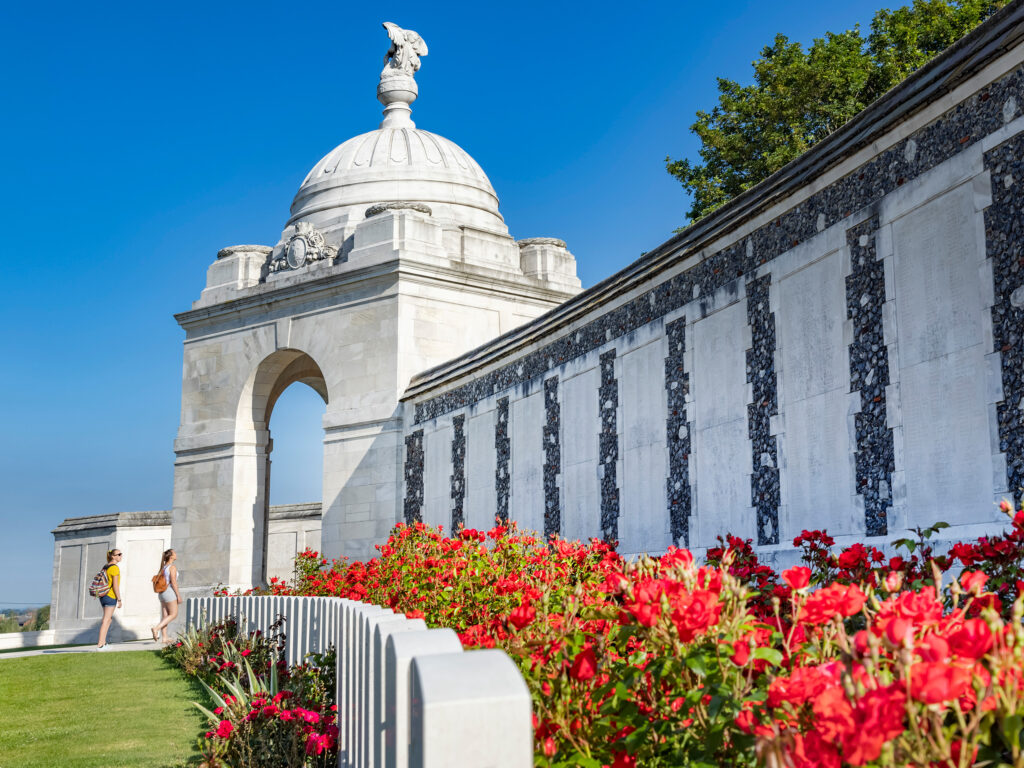Tyne Cot Cemetery
CWGC Tyne Cot Cemetery is an impressive yet understated haven of tranquillity that extends through the former battle landscape. With its 11,956 graves, it is one of the largest Commonwealth cemeteries in the world and it is a silent witness to the bloody Battle of Passchendaele. During the British offensive of 1917, almost 600,000 victims fell in 100 days for a territorial gain of only eight kilometres.
‘Tyne Cot’ was originally a German defence position on the first line in Flanders. In October 1917, the Australian troops established an aid station there that soon grew into a small cemetery with 340 graves for the soldiers who had succumbed to their injuries on the spot. After the war – between 1919 and 1921 – the British ‘Exhumation Companies’ collected 12,000 dead from the surrounding battlefields. Of these, only 3,800 bodies could be identified. The wall behind the cemetery contains the names of 35,000 soldiers with no known grave. They include British, Irish and New Zealanders who perished in the region after 16 August 1917. The cemetery was designed by Sir Herbert Baker and inaugurated in 1927.
Many tens and even hundreds of thousands of visitors come each year to pay their respects to the men – some still only boys – who lost their lives in the surrounding battlefields. A visit leaves no one unmoved.
Nowadays, the Commonwealth War Graves Commission is responsible for maintaining the cemetery.

Visitor’s centre
The free visitors’ centre, which the British Queen Elizabeth II and the former Belgian Queen Paola inaugurated in 2007, contains much information on Tyne Cot Cemetery and the fallen of Passchendaele. It also offers a panoramic view over the battlefields of 1917. The visitors’ centre is managed by the Passchendaele Museum team.
Unesco World Heritage
In 2023, 27 cemeteries and monuments lying around and near the WW I frontline in Flanders fields were inscribed on UNESCO’s World Heritage List. Three of these sites can be discovered in Zonnebeke: Buttes New British Cemetery, Polygon Wood Cemetery and Tyne Cot Cemetery.
Walking and cycling routes
Several walking and cycling routes pass by Tyne Cot Cemetery. The “Stroroute” is a 10 km walking and cycling route that runs along the former railway line between Ypres and Roeselare. From the Passchendaele Museum, this route forms the best walking connection to Tyne Cot Cemetery and Passchendaele.
The Legacy of Passchendaele connects the castle grounds of Zonnebeke with the historic battlefields on the outskirts of Passchendaele. The walking route is 8,5 km long. The cycling route of 37 km crosses the rolling countryside and takes you past several WWI and non-WWI sites.
Passchendaele Museum
As an ‘open museum’, the Passchendaele Museum establishes the link between the historical facts and the landscape. Important sites are Polygon Wood, the many bunkers and Tyne Cot Cemetery.
A 3 km walking route takes you from the Passchendaele Museum to Tyne Cot Cemetery. It’s possible to combine these two sites on one day. Groups can choose to combine their visit to the Passchendaele Museum with a non-guided visit, guided walk or guided visit to Tyne Cot Cemetery. There are various options, which our reservations team gladly works out for you.
Practical information
You can reach Tyne Cot Cemetery on the following address: Vijfwegestraat 4, 8980 Passendale. There’s a free car park for visitors.
The cemetery is open daily from sunrise until sunset. The visitor’s centre is open daily from 10 AM until 6 PM. Both are free accessible.